Introduction
The Tale of Genji is a masterpiece of Japanese literature. Written in the early 11th century by noblewoman Murasaki Shikibu, this story offers a window into the world of Heian-era Japan. It’s a tale that encompasses romance, politics, and the nature of love. The novel’s influence on Japanese culture is profound, and its themes have inspired countless artworks, particularly in the form of ukiyo-e, a genre of woodblock prints and paintings. In this article, we will explore the background of The Tale of Genji, its significance, and its vibrant depiction in ukiyo-e art.
Background of The Tale of Genji
The Tale of Genji (also known as Genji Monogatari) is often considered the world’s first novel. It follows the life and loves of Hikaru Genji, the “Shining Prince.” Set against the backdrop of Heian Japan, the novel provides a rich portrayal of court life. The narrative spans several generations, offering insights into the intricate relationships among characters. The novel explores themes like the impermanence of life, the complexity of love, and the pursuit of beauty.
The novel’s author, Murasaki Shikibu, was a lady-in-waiting at the Heian court. Her unique perspective allowed her to craft a detailed depiction of aristocratic life. The novel’s episodic nature, with its series of interconnected stories, mirrors the unpredictability of life, which resonates with readers even today.
Importance of The Tale of Genji
The Tale of Genji holds a special place in Japanese culture. It has influenced literature, art, and even film. The novel’s exploration of human emotion and social dynamics provides timeless insights. Its themes of love and loss, coupled with its portrayal of court life, make it a rich source of inspiration.
The novel also plays a pivotal role in shaping Japan’s cultural identity. It’s a symbol of the country’s literary heritage and is celebrated for its artistry. The tale’s influence extends beyond Japan, with translations available in many languages. It’s regarded as a classic of world literature.
Ukiyo-e Art and Its Connection to The Tale of Genji
Ukiyo-e, meaning “pictures of the floating world,” emerged during Japan’s Edo period. This art form includes woodblock prints and paintings that depict various subjects, including landscapes, kabuki actors, and beautiful women. Ukiyo-e artists were particularly drawn to The Tale of Genji due to its compelling characters and evocative scenes.
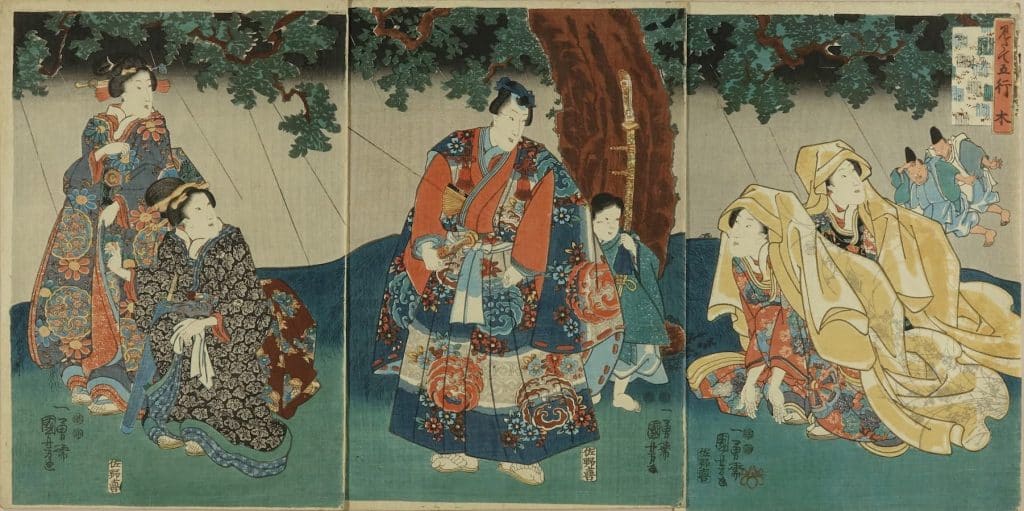
The novel’s vivid imagery lends itself well to visual representation. Ukiyo-e artists often focused on pivotal moments in the story, using vibrant colors and intricate details to capture the tale’s essence. These artworks not only illustrate scenes but also interpret the novel’s themes.
The Art of Genji-e
Genji-e, a subgenre of ukiyo-e, specifically focuses on scenes from The Tale of Genji. This genre reflects the novel’s enduring popularity and the artists’ desire to engage with its themes. Genji-e prints often incorporate elements of Japanese poetry, emphasizing the novel’s literary roots.
Genji-e prints are not just artworks but also cultural artifacts. They reflect the novel’s impact on Japanese culture and the artists’ interpretations of its themes. The prints offer insights into how different generations viewed the novel, revealing changing cultural attitudes and artistic styles.
Nise Murasaki Inaka Genji
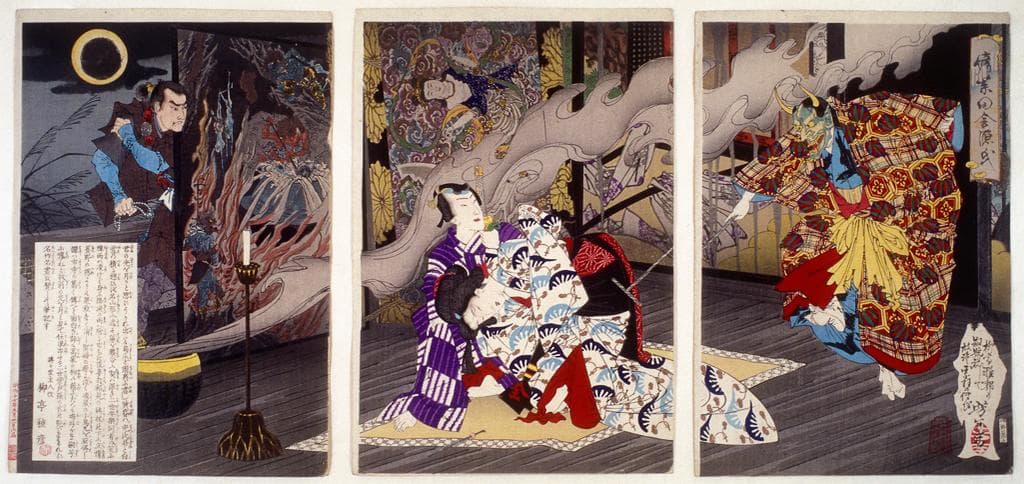
False Murasaki and a Rural Genji (aka Nise Murasaki Inaka Genji) is an 1829 novel by Ryūtei Tanehiko. The book reimagines The Tale of Genji, blending Edo-period settings with the timeless elegance of the original. It adapts the classical Heian-era story, making it relatable to Edo society through contemporary language and social contexts. Tanehiko’s work follows the journey of Ashikaga Mitsuuji, a character based on Genji, who encounters love and intrigue in various rural settings.
This novel was a best seller in its time leading to immense popularity of Genji-e woodblock prints and one ukiyo-e artist in particular became synonymous with the genre.
Utagawa Kunisada’s Illustrated Tales of the Genji
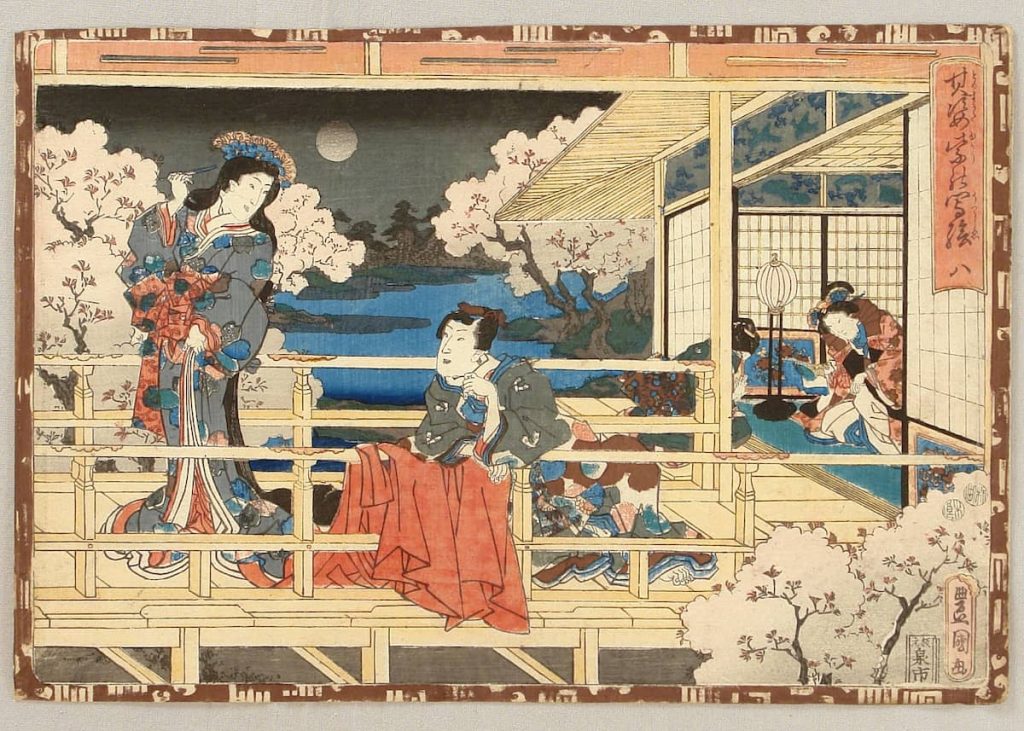
Utagawa Kunisada, also known as Toyokuni III, was one of the most prolific and influential ukiyo-e artists of the Edo period, playing a significant role in illustrating “Nise Murasaki Inaka Genji.” He created woodblock prints that visually interpret Tanehiko’s retelling, bringing the story to life. Kunisada’s illustrations were a vital element in the book’s popularity, as they connected readers to the vibrant world Tanehiko envisioned.
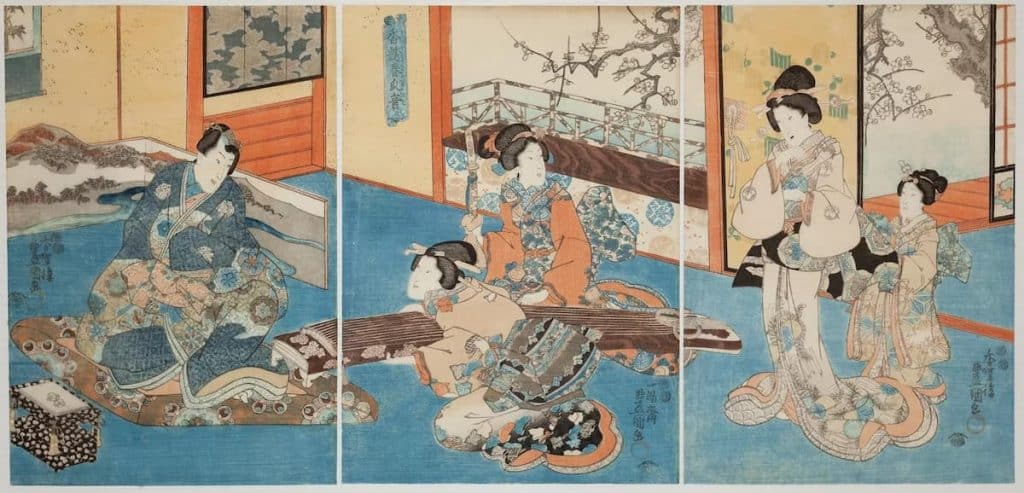
His style, characterized by dynamic compositions, bold color palettes, and careful attention to costume details, made the illustrations engaging and expressive. For example, Kunisada’s depiction of Mitsuuji often emphasized the character’s charisma and elegance. By translating Tanehiko’s narrative into vivid imagery, Kunisada helped make the “Nise Murasaki Inaka Genji” accessible and captivating. His work transformed this literary adaptation into a visual feast that resonated with readers, securing its place as one of the most beloved Edo-period novels.
Art of The Tale of Genji on Hand Scrolls and Screens
The Tale of Genji has been captured extensively on hand scrolls (emaki) and screens (byōbu), showcasing both its narrative complexity and visual richness. These traditional Japanese art forms effectively encapsulate the novel’s themes, bringing the characters and settings to life with intricate detail.
Hand Scrolls (Emaki)
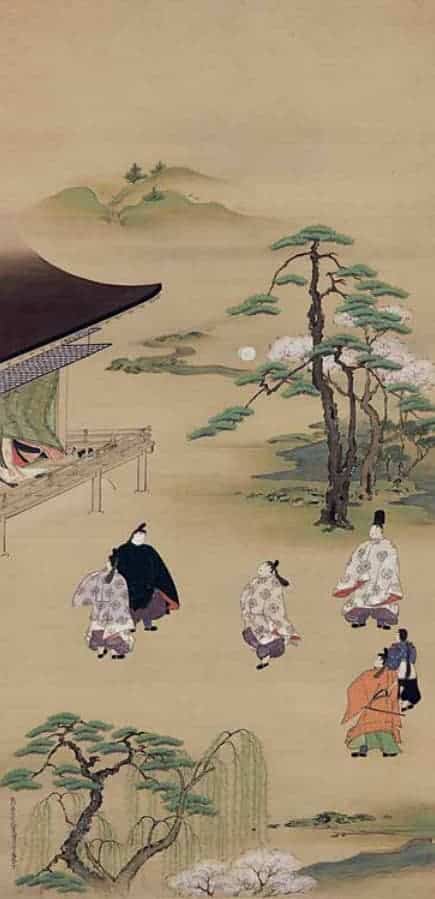
Hand scrolls illustrate The Tale of Genji in a continuous narrative format. One of the earliest surviving examples is the Genji Monogatari Emaki, dating back to the 12th century. This scroll is considered a National Treasure and features iconic scenes that follow Prince Genji’s romantic escapades and political ambitions. The scrolls, characterized by their horizontal narrative, include paintings interspersed with textual passages, showcasing an interplay between image and story. They are notable for their “blown-off roof” perspective, which allows viewers to peer into courtly life. This technique, paired with subtle color gradients and emotional expressions, conveys the story’s depth.
On left: Kemari – Scene from Chapter 34 The Tale of Genji – Hanging Scroll by Reizei Tamechicka
Screens (Byōbu)
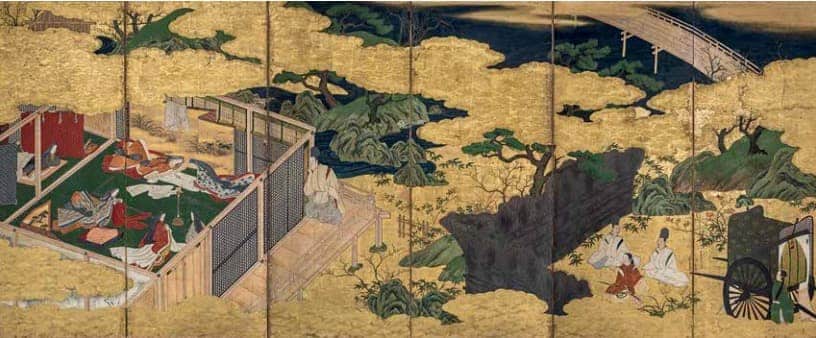
Screens, on the other hand, were often used to depict major scenes across broader panels, making them suitable for public and private spaces. For instance, the pair of folding screens from the 16th century, “Genji Monogatari Folding Screens,” beautifully translates the novel’s episodes into vivid panels, each focusing on key moments like the “Battle of the Carriages” or Genji’s exile. The compositions rely on bright pigments and gold leaf, providing a striking contrast and narrative clarity. They were commonly commissioned by wealthy patrons who wished to celebrate the cultural heritage of The Tale of Genji.
Conclusion
The Art of Genji exists in many forms. While there are beautiful examples of ukiyo-e art (Genji-e) that depict scenes from the story, there also exist hand scrolls, screens, kimonos, vintage playing cards, ad decorative objects. In more recent times, we can also find manga art related to the Genji.
For a more in-depth look at the various forms of the Art of Genji read The Tale of Genji – A Japanese Classic Illuminated by The Metropolitan Museum of Art.
The Tale of Genji is a cultural treasure. Its themes resonate across centuries, and its influence on Japanese art is profound. Ukiyo-e artists, captivated by its rich narrative, have created stunning visual interpretations of the novel. These artworks not only illustrate scenes but also offer insights into the characters and themes. Through the lens of Geni-e, The Tale of Genji continues to captivate audiences, demonstrating the timeless appeal of this classic tale.
Frequently Asked Questions on Genji-e
Why is The Tale of Genji significant?
The Tale of Genji is significant for its literary merit and historical value. It’s often considered the world’s first novel and offers insights into Heian-era Japan.
Who are some notable ukiyo-e artists who depicted The Tale of Genji?
Notable artists include Kitagawa Utamaro, Katsushika Hokusai, and Utagawa Toyokuni. Each brought their unique style to their interpretations.
What is Genji-e?
Genji-e is a subgenre of ukiyo-e focused on scenes from The Tale of Genji. It reflects the novel’s popularity and the artists’ engagement with its themes.
Why are Genji ukiyo-e prints collectible?
Genji ukiyo-e prints are collectible for their artistic value, historical significance, and connection to a literary classic.
Read more:
- Collecting Ukiyo-e Art: A Guide for Beginners
- 11 Most Influential Ukiyo-e Artists: Masters of Japanese Woodblock Prints
- The 12 Most Important Ukiyo-e Artworks of All Time
- Kuniyoshi Utagawa: A Master of Ukiyo-e and Musha-e
- The Timeless Tradition of Hanko in Japanese Art and Ukiyo-e

At The Art of Zen we carry a selection of our own hand-crafted original Japanese art prints in the ukiyo-e and Japandi style. Some of our best selling work is Mount Fuji wall art and Japandi wall art.
Add some zen to your space with brilliant original art from the Art of Zen shop.
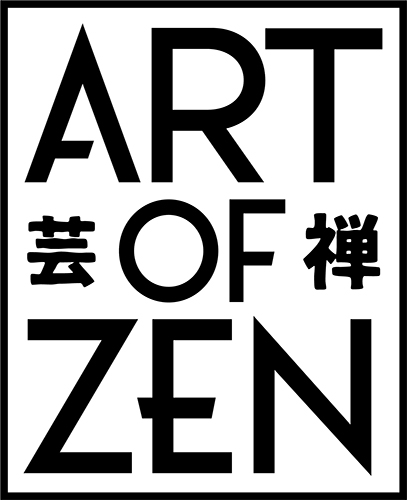

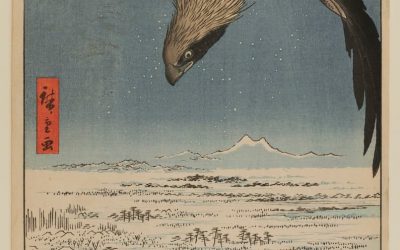
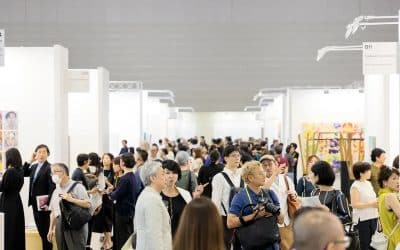
0 Comments